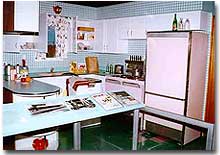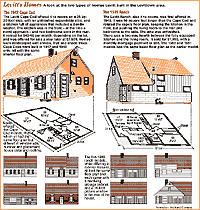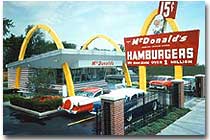53b. Suburban Growth

Convenience and color were two hallmarks of the 1950s kitchen. Pink refrigerators and new pre-sweetened cereals such as Sugar Pops were introduced to America early in the decade.
For many generations and many decades, the American Dream has promised an egalitarian society and material prosperity. For many, the notion of prosperity remained just a dream.
But for millions of Americans in the 1950s, the American Dream became a reality. Within their reach was the chance to have a house on their own land, a car, a dog, and 2.3 kids.
Postwar affluence redefined the American Dream. Gone was the poverty borne of the Great Depression, and the years of wartime sacrifice were over.

William Levitt offered five different versions of each type of home, but all had the same floor plan.
Automobiles once again rolled off the assembly lines of the Big Three: Ford, General Motors, and Chrysler. The Interstate Highway Act authorized the construction of thousands of miles of high-speed roads that made living farther from work a possibility.
Families that had delayed having additional children for years no longer waited, and the nation enjoyed a postwar baby boom.
Suburbia

William Levitt revolutionized the way Americans live and ushered in an age of suburbia by providing inexpensive housing outside the city.
Racial fears, affordable housing, and the desire to leave decaying cities were all factors that prompted many white Americans to flee to suburbia. And no individual promoted suburban growth more than William Levitt.
Contracted by the federal government during the war to quickly build housing for military personnel, Levitt applied the techniques of mass production to construction. In 1947, he set out to erect the largest planned-living community in the United States on farmland he had purchased on Long Island, New York. Levitt identified 27 different steps to build a house. Therefore, 27 different teams of builders were hired to construct the homes.
Each house had two bedrooms, one bathroom, and no basement. The kitchen was situated near the back of the house so mothers could keep an eye on their children in the backyard. Within one year, Levitt was building 36 houses per day. His assembly-line approach made the houses extremely affordable. At first, the homes were available only to veterans. Eventually, though, Levittown was open to others as well.
Keeping Up with the Joneses
With the ability to own a detached home, thousands of Americans soon surpassed the standard of living enjoyed by their parents. Nevertheless, the movement was not without its critics. Architects called Levitt's designs and emphasis on conformity an abomination.

As suburbia grew, fast food restaurants began to pop up all over the country. Ray Kroc bought a single burger joint called McDonald's and paved the way for the fast food giant. Pictured above is Kroc's first new restaurant, which opened in 1955.
Because little variety was expressed in the construction, homeowners struggled to keep their communities looking uniform. Residents had to pledge to mow their lawns on a weekly basis. African Americans were excluded by practice. The irrational need to "keep up with the Joneses" was born in the American suburb.
Despite such criticism, a generation of Americans loved the chance to avoid rent and the dirtiness of the city to live in their own homes on their own land. Soon, shopping centers and fast food restaurants added to the convenience of suburban life. Thousands and thousands migrated to suburbia.
America and the American Dream would never be the same.






